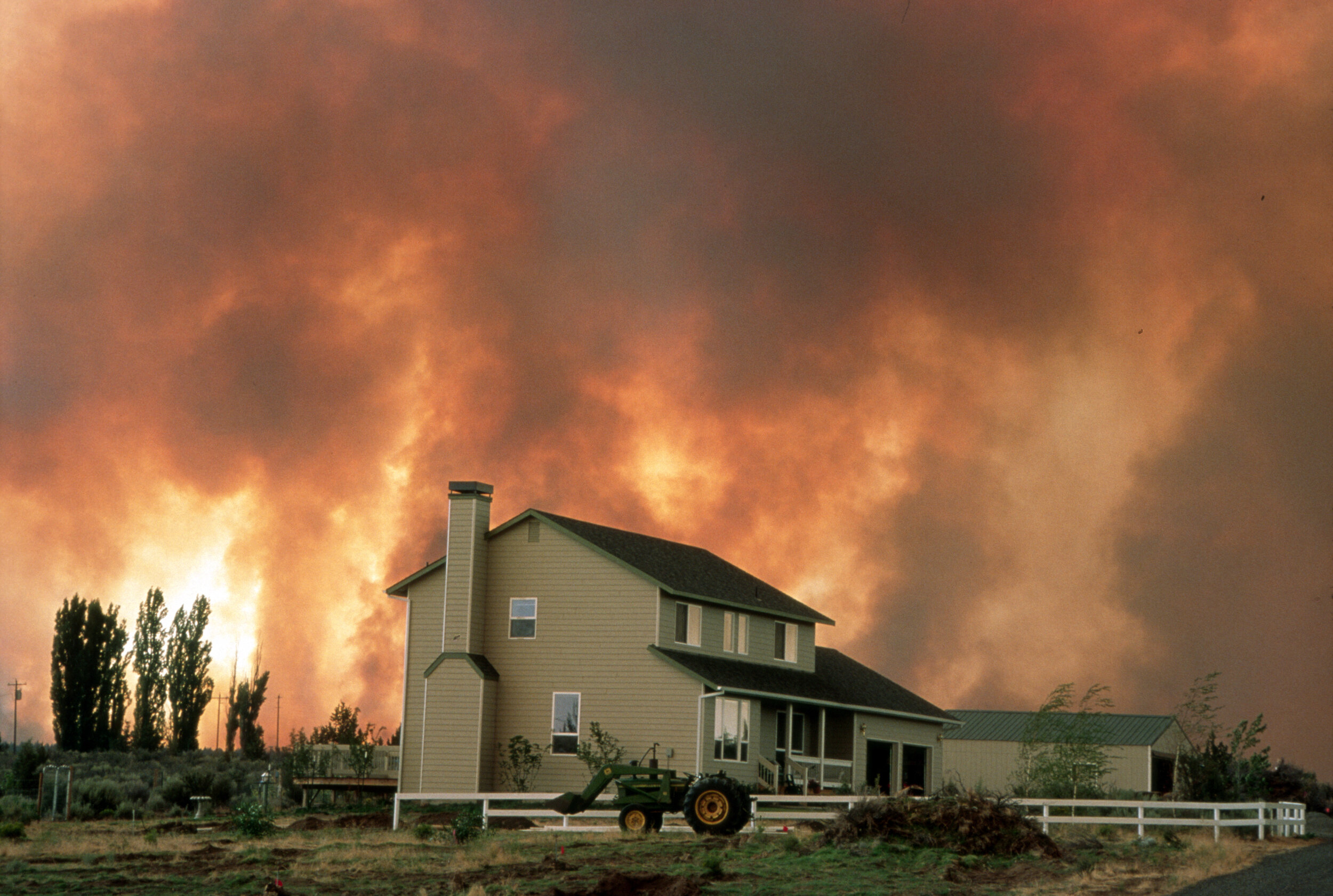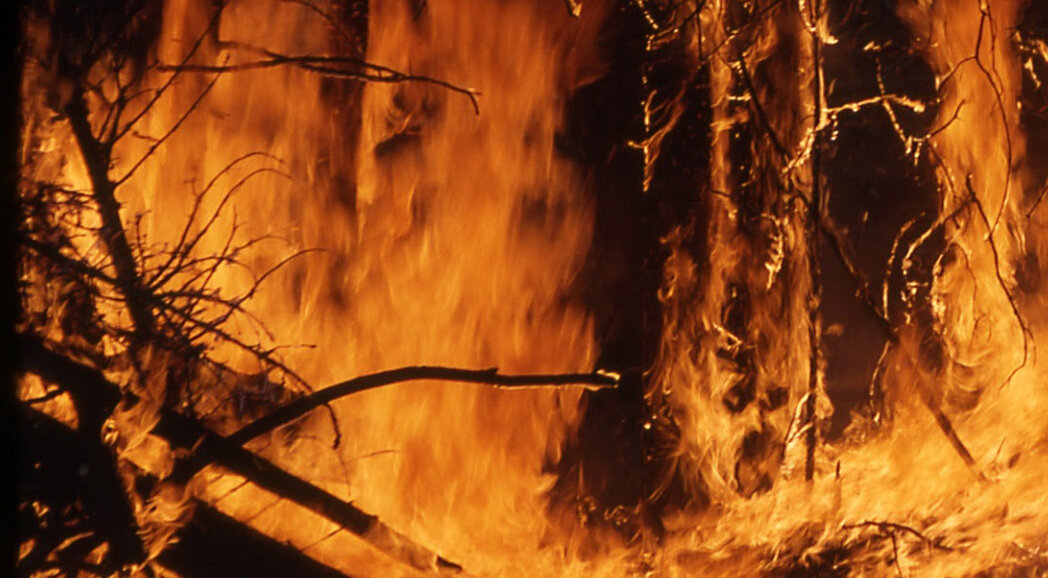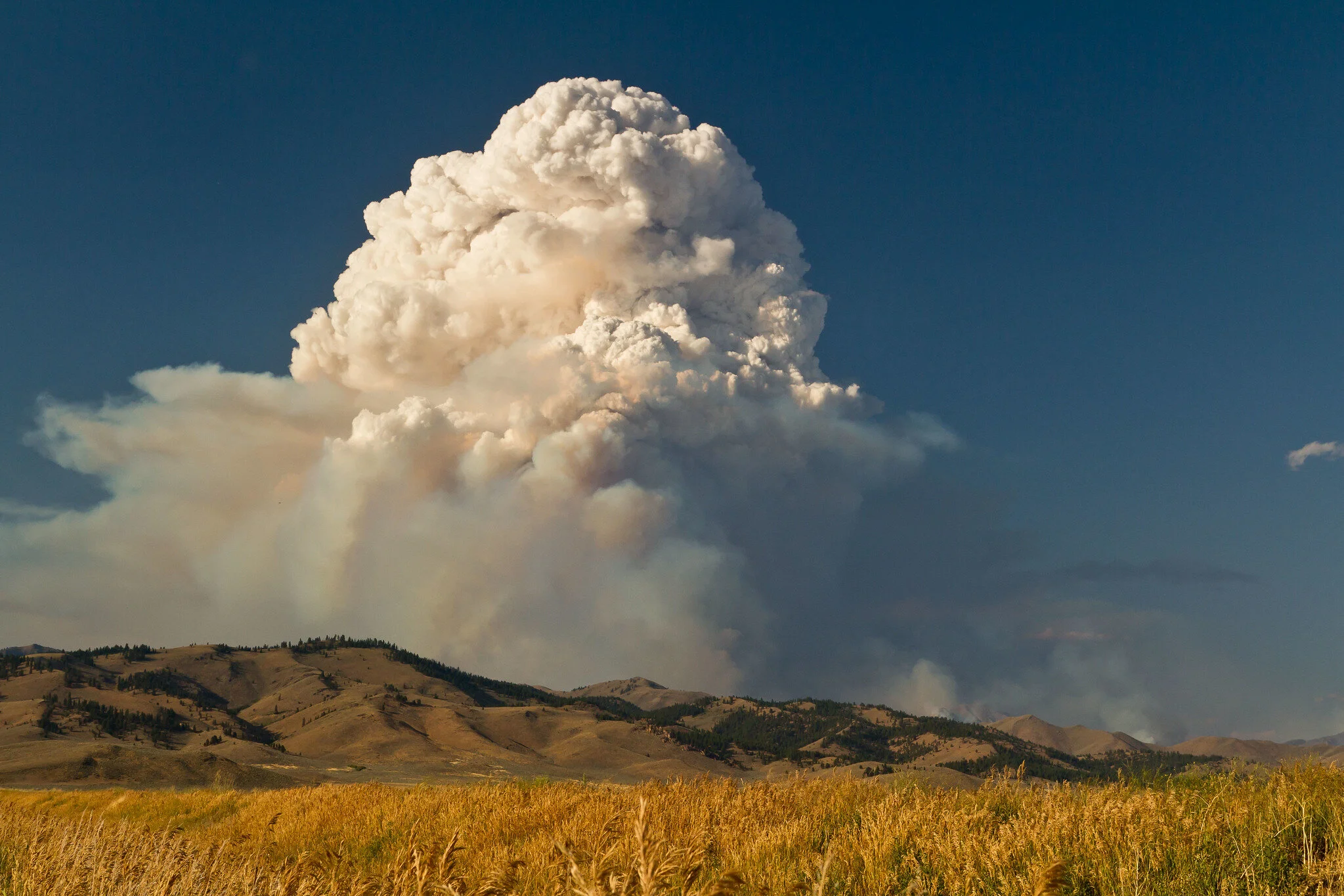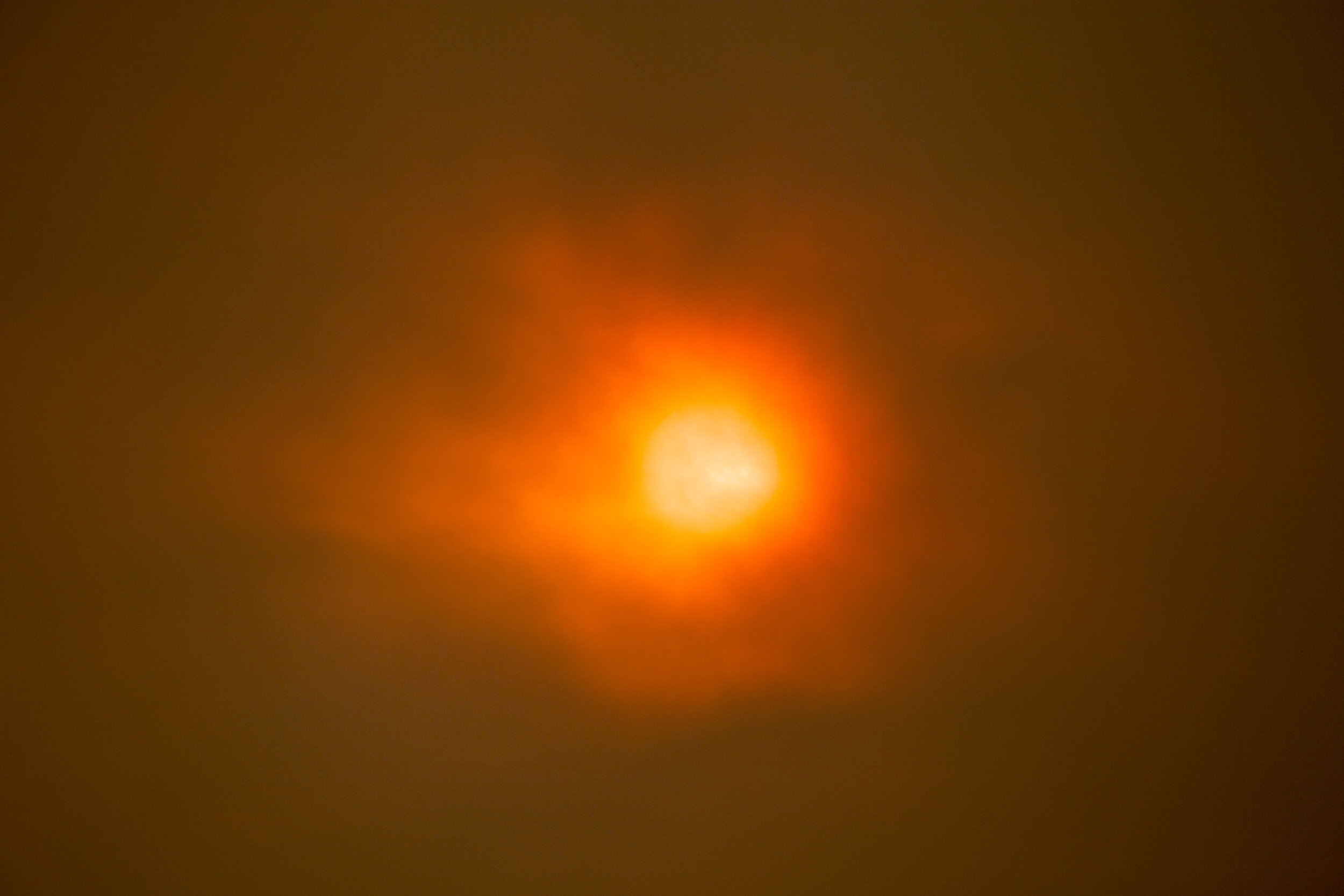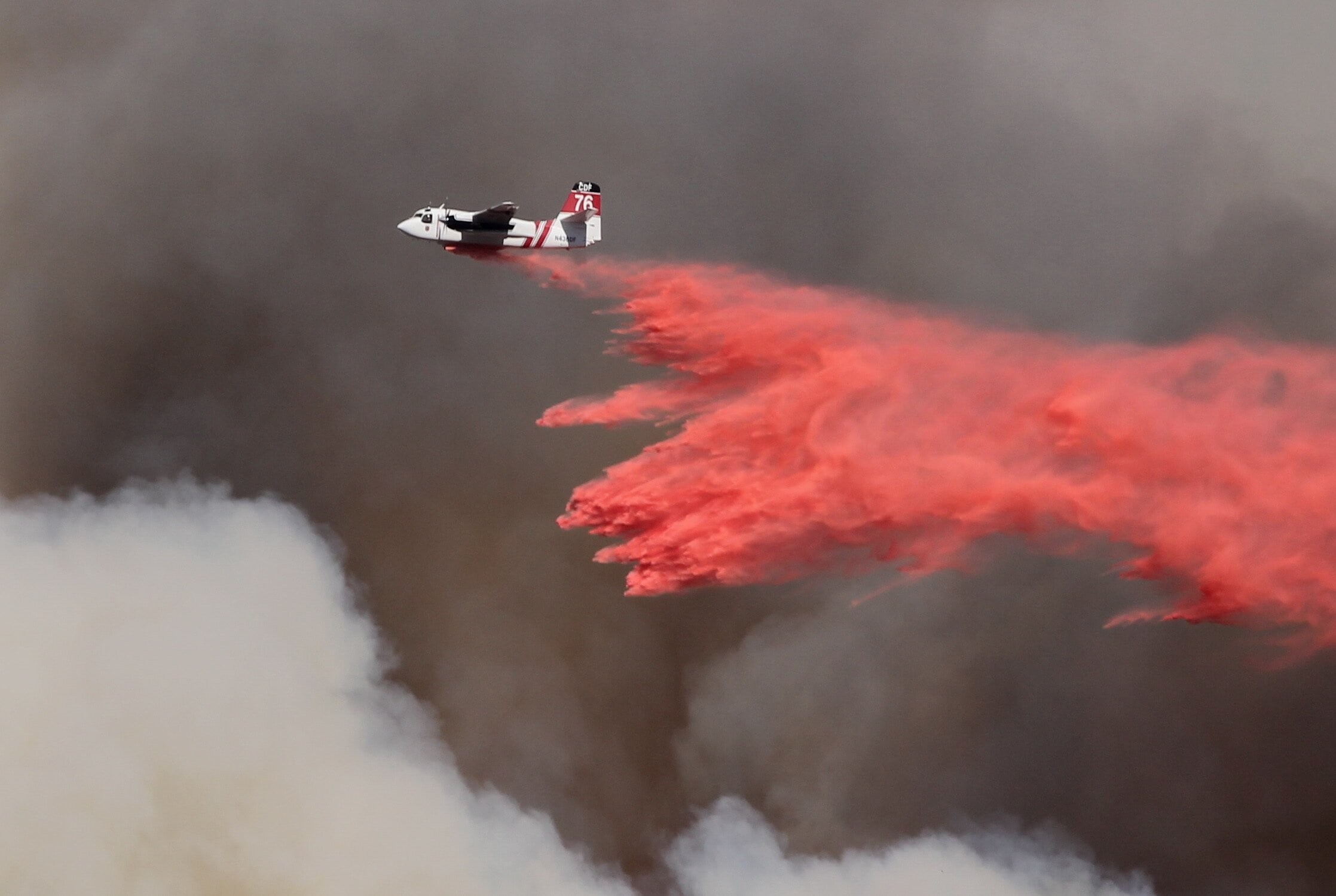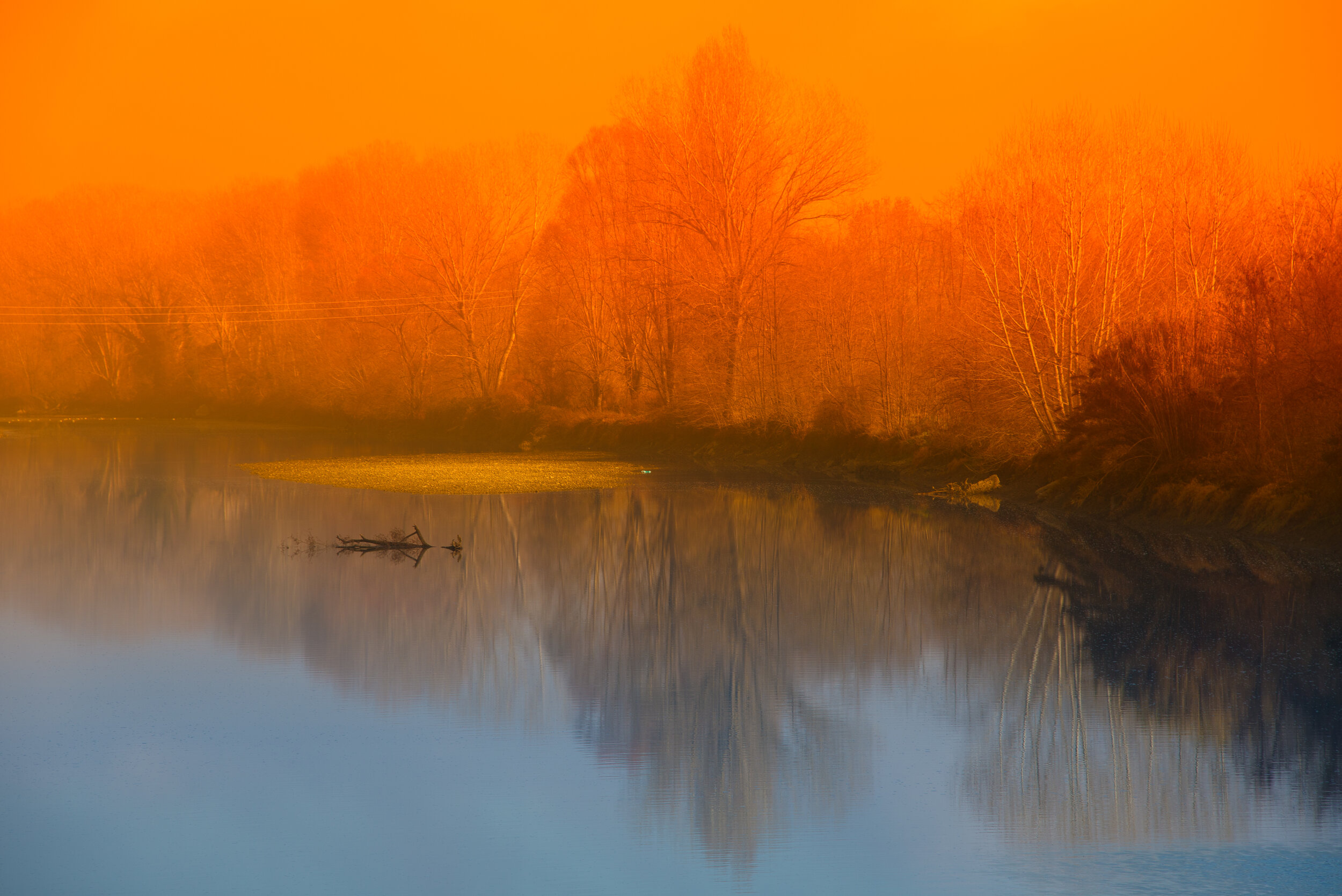1. HOW TO BUILD FIRE-RESILIENT HOMES AND COMMUNITIES
2. HOW TO STAY INFORMED DURING RAPIDLY-EVOLVING CRISES
3. HOW TO STAY SAFE DURING INTENSE SMOKE
4. HOW TO EVACUATE YOUR HOME
Maintain defensible space around your home.
Creating and maintaining defensible space around your home is critical if you live anywhere close to a wildland-urban interface. This means nothing flammable should be next to your house (woodpiles, propane tanks, dry leaves and pine needles, etc.). Trees and large bushes should be spaced apart and away from your home. Defensible space is doubly important. It decreases the likelihood of your home catching on fire, and it also increases the likelihood that firefighters—who may not have the resources to defend all houses, and therefore may be forced to quickly triage houses—will decide to focus their efforts on defending your home.
For detailed information about creating and maintaining defensible space around a home, read Cal Fire’s guide on defensible space.
Consider cultivating fire-resistant landscaping.
Some plants, like Eucalyptus trees and certain species of grass, are extremely flammable (called “flashy fuels”). Their presence near your home and neighborhood may increase the likelihood of your home catching on fire, so they should be avoided if you life in a fire-prone area. Others plants—typically ones with high moisture content that grow close to the ground, and have low sap content—are more fire resistant. Consider removing any flashy fuels from the vicinity of your house and neighborhood, and replacing them with fire-resistant plants instead. Cal Fire has a helpful guide for planning a fire-resistant landscape.
Harden your home: roofs, windows, eaves, and more.
“Hardening your home” means taking steps to increase the likelihood that your home will remain intact in the event of a wildfire. Beyond defensible space and fire-resistant landscaping around your home, it’s important to consider the design and upkeep of your home itself. Things like the material of your roof, the sturdiness of your windows, the design of your eaves can have a huge impact on the resiliency of your home.
UC Davis published a useful in-depth guide that discusses these considerations and more, called Home Survival in Wildfire-Prone Areas: Building Materials and Design Considerations. FIRESafe Marin summarized many of the recommendations from this guide in a user-friendly web page called Harding Your Home Against Wildfire.
Some of the suggestions are costly to execute, while others are relatively easy and inexpensive to implement. For example, make sure you clear your gutters regularly, and remove any debris that has accumulated on the roof, particularly by any side paneling or eaves. Keep all the windows closed in the event of a wildfire. Avoid storing flammable materials under a deck. Make sure attic vents are all covered with a non-combustible mesh screen to keep out embers.
Listen to and amplify voices of local fire practitioners, particularly those who possess ancestral knowledge of cultural burning.
Over thousands of years, indiginous people and cultures in fire-adapted regions have refined the art of utilizing fire to foster increased wildfire resiliency of local ecosystems. Indiginous cultural burning is extremely effective and nuanced, and colonial fire management strategies have yet to achieve the same levels of success. It is important to seek out and listen to the voices of these knowledge-holders, and to center those voices in conversations about wildfire strategies.
Incorporate fire preparedness and resiliency into ongoing community life.
Indigenous practices around fire have been more successful than colonial practices in part because fire strategies are an integral and regular part of many indigenous cultures in fire-prone areas. In comparison, colonial ways of engaging with fire tend to be more sporadic and removed from most people’s everyday lives. One way to increase wildfire resiliency of your community is to find ways to incorporate fire readiness into the social practices of your community. For example, a community could start a monthly gathering where people come together to socialize and work collectively to clear defensible space around the area.
Work together with local government, agencies, and tribes to apply for fire-readiness grants and programs.
Some elements of fire-readiness take considerable resources, which may be cost prohibitive to many communities—particularly to communities most vulnerable to wildfire. There are a number of grants that communities can apply for that will help fund efforts to reduce fuel loads, educate the community on effective fire strategies, and develop community strategies. These grants and programs include:
Federal Funding Available to Address Tree Mortality on Private Forestlands (USDA)
PG&E - Resilient Communities Grant Program - This includes information about previously funded grants. This can be a great source of inspiration if you are interested in organizing your community but are not sure where to start.
1. HOW TO BUILD FIRE-RESILIENT HOMES AND COMMUNITIES
2. HOW TO STAY INFORMED DURING RAPIDLY-EVOLVING CRISES
3. HOW TO STAY SAFE DURING INTENSE SMOKE
4. HOW TO EVACUATE YOUR HOME
Wildfires can spread incredibly quickly. In 2018, the Camp Fire spread faster than a football field per second. While this was an unusually fast-moving fire, it is increasingly common for wildfires to evolve so rapidly that conventional news sources are not able to update their information quickly enough to allow people reacting to the wildfire to make informed decisions.
There are a variety of apps that are intended to push updates to users’ phones in the event of an emergency, though these apps vary—sometimes even event-to-event within the same app—in reliability and timeliness. And during crisis situations, having information about current conditions can mean the difference between life and death.
Keep the news turned on.
If you have local TV or radio, or can access either of those online, it’s a good idea to keep them on in the background. Don’t rely completely on receiving timely information from these channels, because fast-progressing fires sometimes move too quickly for news to keep up, but they still are often a valuable source of information about evacuations, current fire locations, etc.
Use online social networks that allow people to synchronistically share/gather information about current conditions.
Online social networks are often the most effective way to get the real-time information during fast-moving crises. While news stations have the benefit of sharing information that has been vetted for credibility, they are often not able to disseminate updates rapidly or frequently enough for people who need to make decisions about how to respond during a disaster (e.g. when and how to evacuate). Social media, on the other hand, may have potentially thousands of users contributing information about events from their perspective—often in real-time—creating an abundance of data points that can allow a discerning user to triangulate unfolding event and make informed decisions in order to stay safe. One social media platform that can be especially helpful during wildfires and other natural disasters is Twitter.
Twitter is a social media platform that allows users to share short bursts of information, often frequently. While this can make it difficult to develop and communicate nuanced and complex ideas, it does allow condensed information to be shared and viewed quickly—which, during any kind of emergency, can be very valuable. Coupled with the ability to easily cluster information based on hashtags and search terms, Twitter can be a powerful tool for tracking in-the-moment updates. Below are some tips for leveraging Twitter’s capabilities in advance of a wildfire.
Follow accounts that share reliable information about wildfires and/or public safety. There is no one account that will share everything you want to know, so cast a wide net.
Consider following accounts of official national and local agencies that deal with wildland, wildfire and/or public safety information and response, such as the National Weather Service (national and local accounts), the National Forest Service (national and local accounts), the National Park Service, local land management areas, local fire departments, local police departments, local sheriff's departments, regional transportation and infrastructure districts, etc.
Consider also following fire/climate research institutes/labs, researchers, and journalists who focus on wildfire-related stores. Some ones to consider are:
SJSU FireWeatherLab (@FireWeatherLab) - Fire Weather Research Laboratory, Dept. of Meteorology and Climate Science, San Jose State University.
Center for Climate and Weather Extremes (@C3WE_NCAR) - C3WE is a research group dedicated to understanding weather & climate extremes and enhancing societal resilience.
Daniel Swain (@Weather_West) - Climate scientist at UCLA.
Neil Lareau (@nplareau) - Professor of Atmospheric Science at University of Nevada, Reno. Studies wildfire plumes, among other things.
Paul Doherty (@pjdohertygis) - Works in GIS (Geographic Information System Mapping) and often shares great wildland fire maps during major wildland fires.
Beth Schlanker (@BethSchlanker) - Pulitzer Prize winning photojournalist who often covers wildfire stores in Northern California.
Lastly, you may want to consider following accounts of individual people interested in fire and/or public safety, who try to provide credible updates—such as ham radio operators and folks who regularly listen to scanners and live-tweet what they hear. Some examples include AI6YR (@ai6yrham) and CA Fire Scanner (@CAFireScanner).
Search for information using hashtags and key terms. Hashtags are a way of labeling information so that people can search for and read posts with that label/hashtag. Many wildland fires will have their own hashtag (e.g. #CampFire, #CarrFire, #WoolseyFire). You can search for information using these hashtags, and you can also search for information using key terms—or a combination of the two. For example, when my parents were evacuating their home during the Carr Fire in Northern California, I regularly checked for general updates on the fire by searching “#CarrFire,” and I also regularly checked for updates on the status of their neighborhood by searching “#CarrFire Mary Lake” (Mary Lake being the name of their neighborhood).
When using the search feature during rapidly progressing wildfires, make sure you are viewing the “Latest” posts (instead of the “Top” posts). When timeliness of information matters, this is vital.
If you are posting updates, be factual and specific. This is very helpful for people trying to find detailed information. For example, when my parents’ neighborhood was evacuated during the Carr Fire and I was searching for information about the status of the neighborhood, I came across many posts from eye witnesses saying that houses in their neighborhood were on fire. However, these posts often did not indicate the specific location of these houses (e.g. street name, intersection, or part of neighborhood), so it was impossible to guess the status of my parents' house. The posts that included intersections were by far the most helpful.
Designate a friend/family member/loved one who lives in a different area than you to help gather/sort information if you are in an emergency. Sorting through and determining the credibility of information during an emergency takes some time and energy—which are two things that you may not have if you are approaching or in the midst of a potential evacuation. If you have someone who can do this for you and send you a curated stream of information, it will allow you to focus your efforts elsewhere while still staying informed.
Set up emergency alerts (could be app-based, text message-based, and/or web-based).
Many towns/cities/counties have some type of emergency alert service that is supposed to send alerts to users when there is an emergency nearby. There are many different services, so one way you can find alert apps in your area is to do an internet search for “emergency alert app” or “emergency alert system” plus the name of your town/city/county. Note that there may be multiple services for your area. Strongly consider utilizing several—or all—of them. There have been many instances of notification services not sending timely alerts (or any alerts) during an emergency. For example, during the Camp Fire in 2018, a CodeRED app alert was sent out but only about half the people who signed up for the service received an alert. At least 85 people were killed. Maximize the likelihood of having at least one working alert service by setting up multiple options.
One app that I have found especially useful is the free Pulse-Point* app. The app allows users to search for and follow various emergency response agencies, primarily local fire departments. After following one or more agencies, users can view a live feed of any current or recent incidents (including vegetation fires, structure fires, traffic collisions/fires, medical rescues, and more). This can be viewed in chronological list form, or on a map. Users can also choose to listen to the scanners for these agencies, and can set up alerts for specific types of incidents. This is extremely valuable if there is a wildfire near you, and/or a red flag warning (extremely high fire danger, usually due to dryness and high winds). Set up alerts for vegetation fires and keep your phone close so you are notified of any potential wildfire activity right away.
*Note that PulsePoint is not available everywhere. It is only available where adopted by local emergency response agencies.
CodeRED Mobile Alert is another app to try, though successful transmission of timely information has been inconsistent.
Work collectively with friends and family to establish information streams.
As you set up your own alert systems and information streams, be sure to work with family and friends to help them set up their own systems. This can of course be helpful to them if there is an emergency, and it can also allow family and friends to support each other when one person or more is in evacuation mode. If one person is in crisis, family and friends can monitor information streams on their behalf on send them essential information, saving the person in crisis the time and effort of having to sort through all of the information themselves.
Help loved ones stay informed of your status during emergencies by designating one go-to-person who you will keep updated, who will then update your other family and friends.
During emergencies, it’s often impossible to make phone calls, and sometimes even to send text messages (though texts are the most likely to go through), due either to heavy loads of people trying to use the service simultaneously, and/or due to disruptions in service due to the disaster itself (e.g. machinery damaged). Consider designating one person, who lives far enough from you that they would not be impacted by events in your area, to be a conduit for updates. Give that person a list of people—with their contact info included—who you would want to be kept updated if you are in an emergency. Then, in the event of an emergency, you only need to send one message to your designated person and you will know that everyone will be notified.
1. HOW TO BUILD FIRE-RESILIENT HOMES AND COMMUNITIES
2. HOW TO STAY INFORMED DURING RAPIDLY-EVOLVING CRISES
3. HOW TO STAY SAFE DURING INTENSE SMOKE
4. HOW TO EVACUATE YOUR HOME
When wildfires occur, it is natural to focus on the primary phenomena: fire. Less often considered are the hazards from fire’s secondary phenomena: smoke.
Wildfire smoke can be hazardous, particularly smoke from wildland-urban interface fires which may be laced with heavy metals and hazardous chemical compounds from burnt vehicles, electrical appliances, building insulation, etc. The most insidious smoke particles are PM2.5: airborne particulate matter less than 2.5 micrometers in diameter. For scale, a single human hair is about 70 micrometers in diameter, meaning that the largest PM2.5 particle is about 30 times smaller than one of the hairs on your head. PM2.5 particles are so small that they pass easily through tissues, burrowing into lungs and vascular system. Numerous studies (such as this 2018 paper in the Journal of American Heart Association) have found statistically significant positive associations between wildfire smoke density and emergency department visits for cardiovascular, cerebrovascular, and respiratory issues such as myocardial infarction, heart failure, pulmonary embolism, and ischemic stroke. Older adults over 65, small children, and people with asthma were especially likely to be negatively impacted, but negative health effects were observed among otherwise healthy adults.
Potential long-term health effects of wildfire smoke exposure are not well-researched yet, though there is evidence that exposure to air pollution such as wildfire smoke can contribute to neurological conditions, such as Alzheimer’s and Parkinson’s disease.
The most common advice during wildfire smoke events is to stay inside. While this can be good advice, air indoors can be just as noxious as the air outdoors. During the Carr and Camp fires of 2018, for example, the air inside many apartment buildings and houses was so smoky that for days their fire alarms blared continuously. When our surroundings are blanketed by heavy wildfire smoke, staying safe requires more than simply staying indoors. We have to take intentional steps to preserve or create clean air. Below are some practical guidelines to keep yourself and your loved ones safe from dangerous levels of smoke.
GATHER TOOLS AND KNOWLEDGE FOR SAFETY IN ADVANCE.
Have multiple HEPA filters if you live in a building with central air.
By circulating air through a central HEPA filter, you will reduce the amount of hazardous PM 2.5 smoke in your building. Keep a supply of spare HEPA filters so you can replace them as needed. Generally HEPA filters should be replaced every 12-18 months, though during intense smoke events, they may need to be replaced far more frequently (e.g. every week), which is why it’s good to have extra.
Have a stockpile of N-95 or P-100 masks.
Obtain these in advance, because during major smoke events they may quickly sell out. Masks should always have 2 straps. There are generally 3 sizes of masks sold: small, medium, and large. It’s important to try different sizes to learn which one fits you best, because masks must fit tightly against your face to be effective. Note that surgical masks, dust masks, etc. will NOT protect you from the harmful particulate matter in wildfire smoke. Check to make sure your masks have the words “NIOSH” (for the National Institute of Occupational Safety and Health, who tests masks) and either “N95” or “P100”.
The Environmental Protection Agency (EPA) has a helpful guide to choosing the best mask for you.
Have a supply of non-perishable foods.
During major smoke events, it is important to limit exposure to outdoor air as much as possible (even if you have an N-95 or P-100 mask; those should be used only if going outside is absolutely necessary). In order to avoid having to go outside, it is helpful to have enough food that you do not have to leave to go to the grocery store for at least several days. (Distribution routes to stores are also sometimes disrupted during wildfires and other emergencies, so this is a good practice in general.) Non-perishable food that you do not have to cook (cooking increases the fumes inside your house, which are especially important to limit during wildfires) are best.
If you have heart or lung condition, or any other condition that might be exacerbated by smoke, talk with your doctor in advance.
If you need to have specific medicine or follow specific protocols, make sure you are prepared.
Reduce drafts in your home, if possible.
Harmful particulate matter seeps into homes through drafty fireplaces, windows, and doors. For windows and doors, check periodically to make sure your they are adequately sealed, and add weather-stripping as needed. For fireplaces, check to see if your flue closes all the way.
Have materials to smoke-proof your home (especially important for drafty homes).
Many homes—particularly older buildings—are drafty regardless of how well they are maintained. Harmful particulate matter can enter your house through these drafts. Have a supply of plastic drop-cloth/plastic sheeting (enough to cover doors, windows, fireplaces, etc.), and several roles of painter’s tape, to make sure you are prepared to seal drafts in the event of a major smoke event.
Consider purchasing or making air purifiers for individual rooms.
Air purifiers for individual rooms are especially important if you live in a drafty home, or without a strong central air filter. There are a wide variety of commercially available HEPA air purifiers. The EPA has a helpful Guide to Air Cleaners in the Home that walks the reader through various considerations when selecting an air purifier. Consumer Reports also has a guide to picking out air purifiers that focuses more on specific products currently available on the market. Important note about purchasing air filters: be sure to avoid air purifiers that create ozone.
Alternatively, consider making your own air purifier for about $25 using a box fan and a standard HEPA filter. These DIY air purifiers clean the air almost as well as a commercially available air filter, for a fraction of the cost.
During a smoke event: stay informed, hydrated, and in clean air spaces as much as possible.
Keep indoor air as clean as possible.
Do not vacuum, light candles, have fires, or anything else that will stir up or create unnecessary particulate matter. Use HEPA filters and air purifiers (and replace them when they turn brown or the indicator light turns on). If you are using a central air-conditioner, close the fresh-air intake. If your house has any drafts (e.g. fireplaces; drafty windows or doors) seal them with plastic drop-cloth and tape. Open doors as infrequently as possible. When driving in a vehicle, set the airflow to recirculate.
If it is not possible for you to keep the air inside your home purified, consider spending time in public buildings with air purifiers. The best locations will have multiple sets of doors (which slow the encroachment of smoke) as well as central air filters. Some communities will have designated clean air spaces or clean air shelters.
Avoid exposure to air outside.
Even if you have N95 or P100 mask, it’s best to stay indoors. N95 and P100 masks are not 100% effective, and can cause a false sense of security. Stay indoors in filtered air as much as possible.
If you have to go outside, make sure you properly use an N95 or P100 mask.
The CDC has a helpful guide on how to properly put on and take off a respirator mask. The bottom of your mask should fit under your chin. The bottom strap of the mask should go under your ears around the back of your neck while the top strap of the mask should go above your ear around the back of your head. With both hands, mold the nose of the mask around the bridge of your nose. The mask should fit snugly.
A few additional notes:
When you are not wearing your mask, you should keep it face down inside a paper bag or other breathable container.
Make sure your mask is clearly marked as yours, to avoid mixing it up with someone else’s. (e.g. You can write your initials on the front with a sharpie.) It is important to not share masks in order to limit exposure to potential contagens, and because after the mask has been properly molded to one person’s face, it will not fit someone else’s face as well and will therefore lose effectiveness.
Masks should never be stacked on top of each other in between uses. (If the outside of a mask that has been worn outside touches the inside of another mask, the inside of that mask will be contaminated with particulate matter, which the wearer of that mask will then breathe in the next time they put on the mask.)
Do not touch the inside of your mask, especially with contaminated hands.
While outside, the mask should be on your face at all times. If you take the mask off while outside, particulate matter in the air will quickly contaminate the inside of the mask, and then the next time you wear it you will be breathing in that particulate matter.
Masks have limited life spans, typically 1 day outside during smoke events. If it becomes difficult to breathe air in through the mask, that may mean it has become clogged/saturated and it is time to throw that mask away and start using a new one.
Masks with valves are far more comfortable to breathe through than simple masks without valves. If you anticipate wearing your mask for any length of time, consider getting masks with valves.
Monitor air quality regularly.
Monitor air quality regularly whenever there is wildfire activity near you. (Note that “near you” can extend to hundreds of miles away, particularly in the case of large fires. Here are helpful resources to stay informed about air quality conditions:
PurpleAir.com - PurpleAir is a crowd-sourced network of wifi-enabled air quality monitors located around the world. With an abundance of sensors scattered across the US and many other countries, the data is usually quite location-specific, which allows a greater degree of accuracy. Data on the site is also updated in real-time, though you can also change the setting to view average air quality over intervals such as 10 minutes, 1 hour, 1 day, 1 week, etc. As long as there are sensors near you, this is a great resource for getting very accurate air quality readings.
If there are no sensors near you, consider whether purchasing individually, or collectively with neighbors, is a good option for you and your community.
A note about using PurpleAir: some sensors are outside, while others are located indoors. The indoor sensors are helpful only to the people inside that building, and don’t provide meaningful information about ambient air quality to other members of the community. Depending on what type of device you’re using to view PurpleAir, indoor sensors are indicated either with a solid black ring around the data point, or by a house icon around the data point.
Smoke Sense App - The Smoke Sense App is created by researchers at the Environmental Protection Agency (EPA) who describe it as “a research project that enables citizen scientists to engage with a mobile phone application to explore current and forecast maps of air quality, learn about how to protect health from wildfire smoke, and record their smoke experiences, health symptoms, and behaviors taken to reduce their exposures to smoke.” It allows users to contribute to the scientific study of wildfire smoke effects on people while benefiting from useful information such as “Fire & Smoke Near Me Map.” It also includes two smoke forecasting features. A quick view of tomorrow’s smoke forecast is located on the home screen (in addition to current smoke conditions at the nearest sensor), and the “Fire & Smoke Near Me Map” has a helpful hourly forecast for the next 2 days (tap on the “Future” button in the map to access this).
AirNow.gov - In the United States, you can find official air quality readings at AirNow.gov. However, the accuracy of this data is limited because the sensors collecting the data are usually spaced far apart from one another, leading to rough generalizations of the data across large swaths of geography. The data on the site is also updated less frequently than some other sites. It includes a smoke forecast feature, though it often does not work.
Some communities also have local air quality data on websites or apps. You can search for these online if you are interested.
A few additional notes about monitoring air quality:
When monitoring air quality, be sure you are looking at PM2.5 readings. Many resources will also have the option to view PM10 readings. Because PM2.5 particles are generally more dangerous to humans than PM10 particles, those are the readings you should pay closest attention to.
Air quality is typically communicated in one of two ways: either µg/m3 for a particular pollutant, or overall AQI. The concentrations of specific pollutants are measured using µg/m3, which refers to micrograms (one-millionth of a gram) per cubic meter of air. Concentration of many atmospheric pollutants, like PM2.5, carbon monoxide, and sulfur dioxide, are all measured this way. To understand how healthy or unhealthy the air is on a given day, one must look at µg/m3 readings for many different types of pollutants. The µg/m3 readings for each pollutant are precise, but the numeric values do not intuitively correlate to degrees of safety, and the scales are not consistent across different pollutants. Because µg/m3 readings are not particularly user-friendly for most people, the AQI index was developed to more concisely and easily communicate overall levels of air quality.
If you’re interested in learning more, consider reading this article on How Air Quality and the AQI are Measured.
Stay well hydrated.
Hydration is vital for the proper functioning of every system in your body, including your heart, brain, and lungs. This is especially important during periods of intense smoke, when those systems may be experiencing additional stress. Staying hydrated can ameliorate some of the negative effects of wildfire smoke on human health, such as labored breathing, scratchy throats, itchy or burning eyes, and irritated sinuses.
Stay informed!
If you are interested in reading more about wildfire smoke safety, consider reading the 2019 Wildfire Smoke Guide for Public Health Officials. This guide was a collaborative effort between the U.S. Forest Service; the U.S. Environmental Protection Agency, the U.S. Centers for Disease Control and Prevention, the California Air Resources Board, among others.
If you find yourself in a situation where you need to evacuate your home, it’s best to be prepared in advance. Often evacuations happen quickly, and every minute of preparation in advance can make a huge difference.
Start preparing and forming good habits now.
While evacuations are inherently stressful, forming good safety-oriented habits and starting to prepare now will make an evacuation significantly smoother.
Prepare an emergency evacuation grab & go bag in advance.
During an evacuation, you may not have time to grab important items. Many of these items can be assembled in advance in bag or box that you can easily grab if you have to unexpectedly evacuate. Ideally, a grab & go bag will contain everything you need to survive for at least 3 days. Consider customizing this sample grab & go bag.
Identify multiple evacuation routes from your home, work, and any other location where you spend significant time.
Wildfires can move incredibly quickly. It’s advisable to have multiple exit routes planned in advance so that if you need to make quick changes to your evacuation route because of fire (or because of traffic or any other obstacle), you are prepared.
If you have a car, always keep your keys in the same place when you’re not using them.
There have been many instances where people in evacuation zones had only minutes to escape. Knowing the location of your car keys can make the difference between life and death.
If you have a car, always keep the gas tank at least half full, if you are able.
Gas stations are often extremely busy or inoperable during emergencies. Make sure you are able to get out of the range of the immediate emergency by keeping a half tank of gas in your tank.
If you have a car that is kept inside a garage, make sure you know how to open the garage door even if you have no power.
During wildfires—and even during times of heightened wildfire risk—neighborhoods and communities may not have any power, either because of disruptions to electrical equipment or due to intentional power shut-offs. Make sure you know how to manually open a power-operated garage door when power is shut off.
If you do not have a car, make a plan in advance for how you would evacuate.
Friends and neighbors are great resources! If you do not have access to a car, but have friends or neighbors who do, talk with them in advance about teaming up in the event of an evacuation. (Conversely, if you do have access to a car and have friends/loved ones/neighbors who do not, check with them to see if they have a plan or if they need any support.)
If you have a house: turn on the lights inside your house before you evacuate.
During wildfires, smoke is sometimes so thick that it obscures the sun, casting everything in darkness. Turning on the lights inside your house can help firefighters to see there is a house that may be in need of defending.
If you have sprinklers and/or garden hoses, feel free to use them before you evacuate to dose your home, but turn them off before you leave.
Running hoses and sprinklers can decrease water pressure in your community. This water pressure is often crucial for firefighters to be able to defend your home and your neighbors’.
Tip: if you need to quickly wet down your yard, drip a little bit of dish soap into the water stream of your hose. The soap will decrease the water’s surface tension which allows it to soak into the ground faster.
Identify a shelter-in-place location (e.g. a large, well-irrigated grassy field), and talk about this with your neighbors.
Occasionally, such as during the 2018 Camp Fire in Northern California, there is simply not enough time to evacuate out of the wildfire area. In these cases, you can increase your chances of survival by having one or two predetermined shelter-in-place locations close to your home. Shelter-in-place locations should be places that are more easily defendable from wildfire, like a large well-irrigated grassy field (e.g. a school sports field or a cemetery without many trees). Large parking lots and cul-de-sacs have been successfully utilized as a shelter-in-place location in the past, however it is important that there not be flammable cars nearby.
It is helpful to discuss shelter-in-place plans with neighbors in advance. Doing so may help save their life in the event of a wildfire, and it may also help save your life. There have been instances of community members banding together to keep spot fires from encroaching into their shelter-in-place location, combining efforts and resources like fire extinguishers and garden hoses to collectively hold back a wildfire.
Helpful Resources
One Less Spark Campaign (Cal Fire) - Help prevent wildfires by learning how to properly:
Brief Description of Wildland Fire Initiatives, Programs, Networks, and other fire-resiliency efforts taking place around the United States.
Firewise USA - The National Fire Protection Association’s program “teaches people how to adapt to living with wildfire and encourages neighbors to work together and take action now.”
Fire Adapted Communities Learning Network - Provides a wealth of information and resources to support individuals and communities in the continuous process of fire-resiliency.
PurpleAir.com - Check the air quality in your area (or anywhere in the world!) Purple Air is a private company that sells wifi-enabled air quality monitors that allow people to crowd-source air quality data. It is accurate up-to-the-minute, and provides far more data points (meaning it is more accurate) in most populated regions compared to government sources of air quality information.
Climate Toolbox - Fire Danger Mapper
Fire Hazard and Severity Zone Maps
